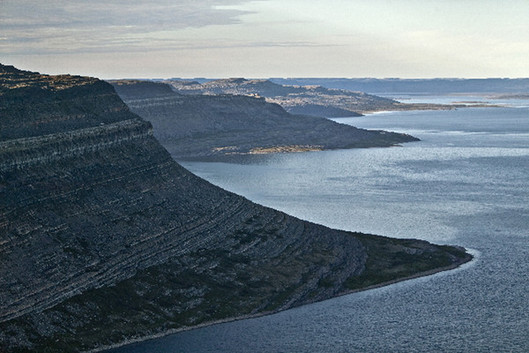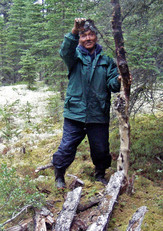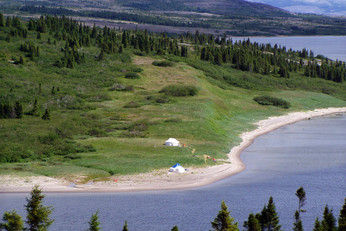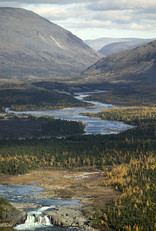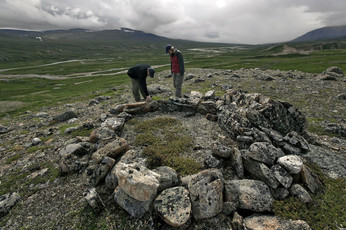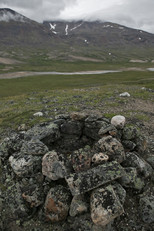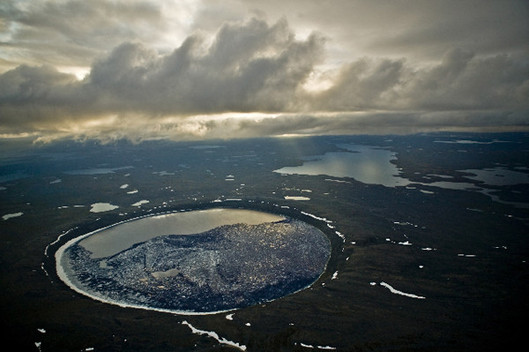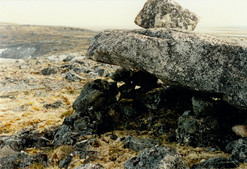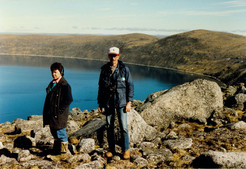- About
- Discovering Archaeology
- Projects and Activities
- Online Resources
- References
Archaeology
Parks in Nunavik
Since 2001In the creation of several parks in Nunavik, the Kativik Regional Administration commissioned Avataq to create an inventory of archaeological resources, and assess the current state of knowledge on each territory.
Tursujuuq Park project (Lac Guillaume-Delisle and Lac à l’Eau-Claire) | 2004-2007
Park description
This proposed park is situated on the east coast of Hudson Bay, near the Inuit community of Umiujaq. A large portion of its territory is typical of the Hudson plateau. The brackish waters of Lac Guillaume-Delisle, a natural haven for migrating seals and beluga whales, are connected to Hudson Bay by a 5-kilometre channel. The lake was formed following a collapse of the Earth’s crust, an event that exposed the geological strata [def] of a sheer wall of rock along the lake’s shore (the cuestas are of glacial origin). The two basins of Lac à l’Eau-Claire, formed by a double meteorite impact, together form the second largest natural lake in Quebec.
Avataq’s mandate
Archaeological research and documentation carried out in conjunction with the creation of Tursujuuq Park sought to establish a knowledge base for an understanding of human occupation of the land (Inuit, Cree and Euro-Canadian). Commissioned by the Kativik Regional Government, Avataq undertook this project in partnership with the Cree Regional Authority.
Research summary
Avataq’s first archaeological inventory of the Lac Guillaume-Delisle region was carried out in summer 2004 by a team led by Pierre M. Desrosiers and comprised of several members of the Inuit community. The project documented more than 70 new (Palaeoeskimo and Thule) archaeological sites, along with about 20 contemporary or recently abandoned sites. Additionally, the team visited many Inuit sites inhabited in the 1950s by members of our guide’s (Willie Kumarluk) family.
In summer 2006, another team, composed of Francis Marcoux, Christian Roy and several members of the Inuit and Cree communities, continued the archaeological documentation of Lac Guillaume-Delisle and Lac à l’Eau Claire, and along the Petite Rivière de la Baleine. The inventory registered the discovery of 50 new archaeological, historical and contemporary sites, of which three are historic indigenous sites with evidence of a Euro-Canadian presence.
The third phase of our work, also consisting of archaeological exploration and documentation, was carried out in summer 2007 at the mouth of the Rivière de la Petite Baleine and at the Fort Richmond site. Research focused on the Hudson Bay Company’s (HBC) Euro-Canadian settlements. Of these, Fort Richmond (HaGb-11) was the first trading post established north of Cape Jones, founded in 1750 in order to facilitate trade with the Inuit.
As a whole, these projects have allowed us to establish the strong archaeological potential of the region. Various sites and structures could draw strong visitor interest in the future park. Thus, the creation of the park will shed light on the rich heritage and traditions of Arctic peoples.
Kuururjuaq Park project | 2004-2006
Park description
Situated on the Quebec-Labrador peninsula, the eastern edge of this proposed provincial park will be the Torngat Mountains, among the highest mountains in eastern North America. The range is located north of the Inuit community of Kangiqsualujjuaq.
Meaning “narrow valley” in Inuktitut, Kuururjuaq Park will be comprised mainly of the deep Koroc River valley. The valley forms an oasis of greenery, an unusual occurrence at this latitude. The proposed park encompasses three distinct natural settings found in Nunavik: the foothills of the Torngat Mountains, the George River plateau, and the coast of Ungava Bay.
Avataq’s contributions
In 2004, the Avataq Cultural Institute carried out a survey of available knowledge on human settlement and an archaeological inventory in the future park territory.
A review of Nunavik’s settlement sequence demonstrates the important role the Koroc River played in the transportation of both people and raw materials. Over several millennia, humans have travelled along the river and built temporary (and possibly long-term) campsites. From an archaeological standpoint, the scattering of Rama metachert [def] along the Hudson Strait and Ungava Bay, along with the presence of several archaeological sites along the Koroc River, strongly indicates that the river played an important role as a passageway through the Torngat Mountains.
Contact: Amélie Langlais, Pierre M. Desrosiers
Pingualuit Park | 2001-2003
Park description
Located in Quebec’s far north, on the Ungava plateau, this provincial park surrounds the fascinating Pingualuit crater lake, formed in the depression created by a meteor collision that took place some 1.4 million years ago. The circular lake, fed only by rainfall and an underground spring, contains some of the purest water on the planet.
Pingualuit Crater is of intense interest to the scientific community. As the layer of sediment at its bottom would have been spared the erosive action caused by moving glaciers, it is a storehouse of precious information about the region’s pre-glacial era.
Avataq’s contribution
In the summer of 1988, Avataq collaborated with Michel Bouchard’s team from Université de Montréal to lead an ethno-archaeological study of resource utilization among the Inuit and their predecessors in the crater region. Our work confirmed the Pingualuit region’s archaeological potential, as evidenced by a preponderance of sites dating from historic times. The Inuit, both historically and recently, have used the crater region for caribou hunting, fox trapping and fishing.
From 2001 to 2003, Avataq also carried out a project assessing the current state of knowledge concerning the territory contained within the proposed park, essentially reaching the same conclusions as in the 1988 publication.
Contact: Pierre M. Desrosiers
Documents en ligne au sujet de ces recherches
Research Report
État des connaissances région du lac Guillaume-Delisle, AR244
Avataq Cultural Institute
2007
Research Report
Inventaire archéologique dans la région du lac Guillaume-Delisle, AR016a
Avataq Cultural Institute
2005

